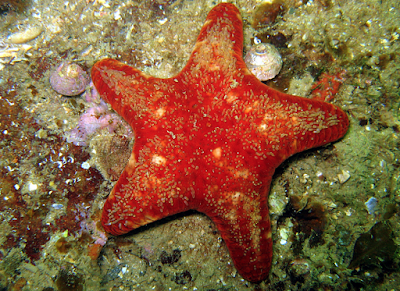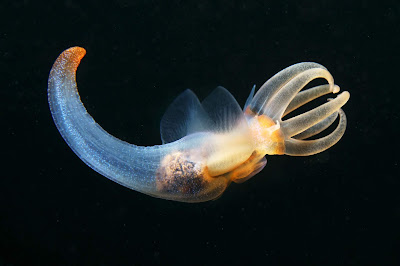Sub Sea Systems Director of Water Operations and Safety
(and our resident fish nerd) Carl Hanson has once again hit the friendly skies and traveled long distances in a short period of time, to bring good TIDE-ings and his expertise to several
Sea TREK operators. Carl added some serious frequent flyer miles to his account and returned with intriguing stories and fond memories of his travels. We interviewed Carl about his latest adventures!
Where did you go on your last two trips?
I went to
Saint Lucia first, arriving on November 9th. Then I traveled to
Puerto Rico on the 13th and
Roatan, Honduras on the 14th. After a brief break, I moved on to Western Australia, leaving on November 25th and returned to the States December 3rd.
How many miles did you travel, round trip?
I traveled from Sacramento, California and back again. The miles break down like this:
Sacramento to Charlotte, North Carolina 2,244
Charlotte to Miami, Florida 650
Miami to St. Lucia 1,504
St. Lucia to Miami 1,504
Miami to Puerto Rico 1,045
Puerto Rico to Miami 1,045
Miami to Roatan 766
Roatan to Dallas 1,317
Dallas to Phoenix, 868
Phoenix to Sac 647
The trip to Australia was next:
Sacramento to Los Angeles, California 373
L.A. to Sydney, Australia 7,488
Sydney to Perth, Australia 2,041
Perth to Sydney 2,041
Sydney to L.A. 7488
L.A. to Sac 373
TOTAL MILES: 31,394!
I really lucked out in Sydney and scored a first class seat, just by chance. My seat included a bed!
What kind of work did you do while visiting each location?
St. Lucia – I did a site inspection, checked in on the team, and made sure training was current. I updated the staff on new Sub Sea products (
Aquaticar, helmet advancements), and asked for feedback on what they would like to see in the future. I also checked out a new dive site for a potential Sea TREK operation, which would cater to hotel guests. The site would be on a different part of the island, about a two-hour drive from the current operation.
Puerto Rico – This post-hurricane visit included follow-up on how the recovery and rebuilding are going. I also checked on staff to see how they are doing. The island seems to be recovering well, outside of the hotels, which are taking longer to reopen. The cruise lines have returned, and will soon be selling Sea TREK excursions.
Roatan – This was a super cool trip! The Sea TREK helmet diving equipment was in storage for quite a long time, and is finally being utilized. Unfortunately, we were not able to get in the water while I was there, due to rough seas. I did a lot of land-based work, including staff training. We also discussed marketing tactics, and I checked out three other possible locations for future Sea TREK operations.

Western Australia – The team at Busselton Jetty introduced me to a potential new location, Rottnest Island. It’s a unique island off the coast of Perth, about a 30-minute ferry ride. The island sees about 700,000 tourists a year. It’s a new tourism entity. It is one of the few places you can find quokka! We checked out three different locations on the island for potential new Sea TREK operations (crystal clear waters abound throughout Western Australia). We then drove from Perth to Busselton Jetty, our current operation. I completed a site inspection, went through the Sea TREK manual with the team, and visited the Jetty. The walkway from the beach to the end of the Jetty, where the helmet dive takes place, is 1,841 meters (6,040 ft.)! A trek all its own. People can walk or take a train to the end of the Jetty, where there is also an underwater observatory and gift shop.
We completed staff training in the water and reviewed safety drills. The water was a “refreshing” 64ºF (18ºC)!
We had a little free time and visited Canal Rocks, massive banks of granite, which eroded along a dead-straight line, forming a striking “canal” feature.
The next day,
Sea TREK Busselton Jetty offered its first day of tours for the season. It was exciting to be present for the “season opener”!
At the end of the trip, I traveled around, took in an aquarium called AQWA, and scouted out some potential sites for other Sub Sea products (
Aquaticar and
FunCats).
What is the best (or most unique) feature of each TREK operation?
St. Lucia is an open ocean location, with a cool sunken car that acts as an artificial reef for sea life. Sea TREK St. Lucia pays homage to some popular St. Lucians; there are typewriters to honor local writers, and other unique photo props.
In Roatan, the landowners (where
Sea TREK is located) work with an animal rescue group, and there is a shelter and monkey rescue right next door to the location. The animals are free to leave, but return frequently!
Western Australia - In terms of places I’ve been, this is one of the most remarkable. The landscape is similar to the US, but wildlife is so different! The Jetty itself is man-made, but attracts an insane amount of sea life. Western Australia is home to 2/3 of the world’s sea grasses, which provide shelter, oxygen, and food for a wide variety of underwater animals such as crabs, octopuses, fishes and squid. Even whales have come through the area and have broken the Jetty! It’s a heavily populated region.
What animals did you encounter while traveling?
Quokka! Kangaroos, some very unfamiliar-looking birds. There were no koalas in this area of Australia. In Roatan, we checked out the monkeys at the preserve.
What surprised you the most?
St Lucia is not known as a diver’s island, but they have some amazing dive sites because of the nutrient-rich waters caused by volcanic ash. In Puerto Rico, I was impressed to learn that they are ready to receive tourists. In Roatan, the weather was surprising, as I didn’t expect it to be raining and windy the entire time I was there; it is not typical for the area.
In Western Australia, I admired the commitment of the staff to operate Sea TREK above and beyond expectations. They go “all out” for their guests, to ensure they have an incredible experience.
What are you going to do with all of those frequent flyer miles?
My best friend is getting married next month. The bachelor party will be in Vegas and the wedding in Phoenix.
Where will Carl head next? Stay tuned to find out!































